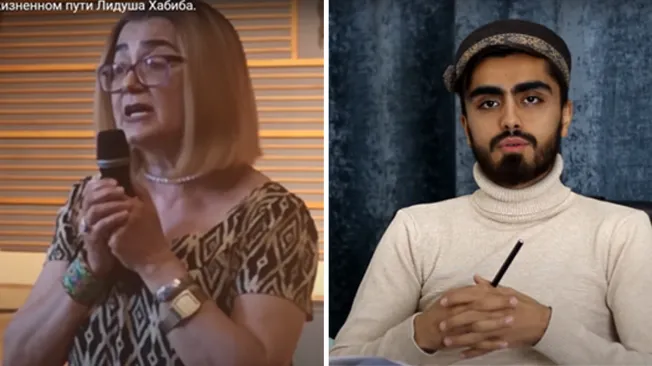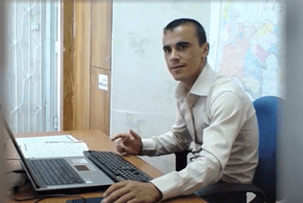In Tajikistan, independent media throttled by state repression
 Giant portraits of President Emomali Rahmon adorn even the most nondescript buildings in Tajikistan’s capital of Dushanbe. Throughout the country, his sayings are featured on posters and billboards. Their ubiquitous presence underscores the consolidation of power by Rahmon – officially described as “Founder of Peace and Unity, Leader of the Nation” – since he emerged victorious from the 1992-1997 Tajikistan civil war that followed the collapse of the Soviet Union. After three decades in power, he has established himself as an absolute ruler with no tolerance for dissent.
Giant portraits of President Emomali Rahmon adorn even the most nondescript buildings in Tajikistan’s capital of Dushanbe. Throughout the country, his sayings are featured on posters and billboards. Their ubiquitous presence underscores the consolidation of power by Rahmon – officially described as “Founder of Peace and Unity, Leader of the Nation” – since he emerged victorious from the 1992-1997 Tajikistan civil war that followed the collapse of the Soviet Union. After three decades in power, he has established himself as an absolute ruler with no tolerance for dissent.
Rahmon’s bid to centralize control includes efforts to silence political opponents, human rights activists, and independent voices. More than a decade ago, Tajikistan’s media environment was relatively diverse and allowed for some criticism and debate, as long as local media avoided reporting on the president and his extensive family. Now, Tajikistan’s media are in their worst state since the violent years of the civil war, journalists told a Committee to Protect Journalists’ representative during a visit to the country late last year and through messaging apps.
Seven journalists were sentenced to lengthy prison terms in retaliation for their work in 2022 and 2023. The United Nations Human Rights Council has criticized “the apparent use of anti-terrorism legislation to silence critical voices” and expressed concern about reports alleging that torture was used to obtain false confessions from prisoners.
In one telling sign of the climate of fear that prevails in Tajikistan, only two among the more than a dozen journalists, press freedom advocates, and experts that CPJ met with were willing to speak on the record.
Some key takeaways from CPJ’s visit:
‘The collapse of independent Tajik journalism’
Prior to 2022, Tajikistan rarely jailed journalists. “For the president [Rahmon], it was important to be able to say we don’t touch journalists,” one local journalist told CPJ.
That changed with the unprecedentedly harsh sentences meted out to the seven convicted in 2022 and 2023 on what are widely seen as charges in retaliation for their work. Four journalists – Abdullo Ghurbati, Zavqibek Saidamini, Abdusattor Pirmuhammadzoda, and Khurshed Fozilov – received sentences of seven or seven-and-a-half years, Khushom Gulyam eight years, Daler Imomali, 10 years, and Ulfatkhonim Mamadshoeva, 20 years – a development seen by many as a deeply chilling escalation in the years-long constriction of independent media.

For Abdumalik Kadirov, head of the independent trade group Media Alliance of Tajikistan, 2022 marked “the collapse of independent Tajik journalism.”
Interviewees told CPJ that only two significant independent media voices now remain in Tajikistan: privately owned news agency Asia-Plus and U.S. Congress-funded Radio Free Europe/Radio Liberty’s local service, the Czech Republic-headquartered Radio Ozodi.
Both regularly face harassment and threats. Their websites have long been subjected to partial shutdowns by local internet service providers – the result of behind-the-scenes orders from state officials, according to local journalists, so that authorities can deny responsibility for the outages.
Asia-Plus has been forced to moderate its content, reducing its political coverage, following a May 2022 threat from authorities to shutter its operations.
A handful of other outlets either avoid political topics entirely, struggle to maintain independence in the face of government repression, or barely function due to lack of funding, multiple sources said. Adding to challenges for journalists are less visible forms of pressure, such as threats of tax fines and surveillance of their work.
“Everything is done indirectly,” one journalist said. “[The authorities] have many levers. They can make it known to a [financially] struggling outlet that it will be hit with huge tax fines, or its management will face criminal charges, and it’s advisable just to lay things down.” Several interviewees said that each media outlet has a “curator” from law enforcement agencies as a reminder that it is being watched, and authorities can threaten rigged tax or other inspections, or even order advertisers to pull their ads.
Particularly since authorities banned the country’s main opposition party in 2015, key independent media have been forced into closure and “dozens” of journalists have chosen exile. A government decree enacted shortly after this requires media outlets to pass an inspection by state security services prior to registration, the head of the National Association of Independent Media of Tajikistan (NANSMIT) Nuriddin Karshiboev told CPJ, with “virtually no new independent media” on the national level being registered since.
Rising fear and self-censorship
The year 2022 had a “devastating” effect on Tajikistan’s already embattled independent media, one journalist said. Several interviewees linked the crackdown on journalists to the authorities’ brutal suppression of protests in the eastern Gorno-Badakhshan Autonomous Region in May-June 2022. Immediately after those protests erupted, authorities arrested 66-year-old journalist and human rights defender Mamadshoeva on charges of organizing the unrest, airing what many believe to be a forced confession days later on state TV.
Four journalists with RFE/RL and its project Current Time TV were attacked after interviewing Mamadshoeva immediately before her arrest, and authorities’ shuttering threat against Asia-Plus was issued over its coverage of events in Gorno-Badakhshan. While most of the other jailed journalists did not cover Gorno-Badakhshan, analysts told CPJ their arrests were in part calculated to have a chilling effect on the press amid the crackdown in that region.
Above all, interviewees said, 2022 entrenched a climate of fear and exacerbated already high levels of self-censorship among journalists. “We don’t know who might be next,” one journalist said. “2022 silenced all of us, not just those who were arrested,” said another. “Journalists fear saying anything.”
Several journalists told CPJ they themselves self-censored more following the events of 2022, which had left increasing uncertainty over “red lines,” the topics that are off limits. “Before it was easier as the red lines were clearer – the president and his family, top state officials, and after 2015, coverage of exiled opposition leaders,” one analyst said. “Now, it’s unpredictable – what you might consider neutral, [the authorities] might not. This unpredictability is the most problematic thing for journalism.”
Others agreed with what Kadirov described as a “dramatic fall” in the number of critical articles and an increasing tendency for local media to avoid domestic politics in favor of “safe” topics such as culture, sport, and some international news.
The convictions of five of the seven jailed journalists in 2022-23 on charges of “participation” in banned political groups allowed authorities to successfully portray independent journalists as “extremists,” several interviewees said. “Society falls for this,” one journalist said, “and members of the public often do not want to speak to journalists, and experts are increasingly wary of doing so.”

The events of 2022 also deepened the sense of alienation between independent journalists and authorities and the public. Where 10 to 15 years ago authorities were forced to reckon with independent media as “a real public watchdog,” noted one analyst, officials now engage less and less with the media, rejecting or ignoring their information requests. Access to information remains “an urgent problem of Tajik journalism,” according to Karshiboev, despite some recent encouraging discussions between authorities and media organizations on how to address the issue.
Decline in international donors
“Tajik media’s biggest problem is finances,” Karshiboev told CPJ. Lacking domestic sources of funding amid a limited advertising market, Tajikistan’s independent media have for years been reliant on international donors, interviewees said. Yet in recent years donor support has significantly declined, particularly since the start of Russia’s war in Ukraine. “All Western resources and attention go to Ukraine,” one analyst lamented. Others cited a longer-term “donor fatigue” – donor organizations have lost interest in Tajikistan in particular and Central Asia more widely “because they don’t see any improvement,” one journalist said. A particular blow was the withdrawal of the Soros Foundation, previously a major media donor, from Tajikistan at the end of 2022.
Others argued that the problem was not so much a decline in donor funding as its misdirection – away from critical media and much-needed measures for media defense and toward projects of questionable value. Among other reasons, several argued that the ultimate problem is that international donors know the media is a sore spot for the Tajik government and, as Karshiboev put it, “fear damaging relations if they provide real and effective support to journalism.”
Interviewees said donors may also feel constrained by the West’s limited ability to influence on human rights issues in a country with such strong ties to Russia and China. “The Tajik government has increasingly learnt that it can act badly without any major consequences,” one analyst emphasized to CPJ. The war in Ukraine has exacerbated that dynamic.
“Before, when there wasn’t this standoff between Russia and the West, Tajikistan still looked to the West,” one journalist said. “Now they think: ‘What can the West do’?”
A bleak outlook
Despite memories of a freer media environment only a generation ago, few of the journalists who spoke to CPJ were optimistic about the prospects for Tajik journalism in the near or mid-term future.
Many noted that Tajik journalists have become “demoralized” following 2022, that there’s been an uptick in journalists fleeing the country or leaving the profession, and that young people are reluctant to choose journalism as a career.
A marginalized independent media sector is very convenient for the government, said one analyst, “so it is unlikely to get better.” External support, in the form of more pressure and better targeted funding from Western and international donors and governments, was one of few factors capable of pushing developments in a more positive direction, several interviewees said. Kadirov and others believe that authorities’ tight control over traditional media outlets will cause independent journalists to turn more to social media and blogging to publish their reporting, making authorities likely to seek to exert even more control over those forums too.
“I see my mission as maintaining independent journalism – I can’t say in a good condition – but maintaining it at least to wait for better days,” said Kadirov.
CPJ emailed the Presidential Administration and the Ministry of Internal Affairs of Tajikistan for comment, but did not receive any replies.
https://cpj.org/2024/01/in-tajikistan-independent-media-throttled-by-state-repression/











